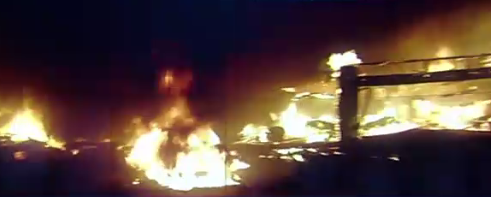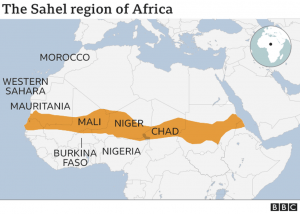
The New York Times: ‘It Burns And It Keeps Burning’: Scenes From Southern California’s Wildfires’ by Jennifer Medina and Jack Healy.
The flames raced across brittle hillsides like advancing armies. Up and down Southern California’s canyons and coastlines, they stormed into neighborhoods and engulfed homes where people were using sprinklers and garden hoses as a last, desperate defense against the wind-driven wildfires.
On Thursday, the hot, dry winds sparked new fires in San Diego and Riverside Counties and up the coast. Nearly 200,000 people were forced to evacuate, and residents in areas already charred by wildfire worried that the strengthening, erratic winds could ignite new fires at any moment.
Fire and smoke forced intermittent closures of the 101 freeway — the main coastal route north from Los Angeles — between Ventura and Santa Barbara, along with several secondary highways and smaller roads. On Wednesday, it had been portions of the 405 freeway closed, which sent long lines of traffic onto surface streets.
Several new fires cropped up, including one in San Diego County that spread to more than 2,000 acres in five hours, destroying and damaging a relatively small number of homes but threatening at least 1,000 more.
Across the region, people wiped stinging smoke from their eyes and huddled inside to avoid the scrim of acrid air. They stood in their front yards and prayed. They sifted through their charred homes, fled to evacuation shelters and said that even in this wildfire-prone state, they had never confronted late-season blazes as fast and ferocious as these.
“We’ve always been under threat of fire; we’re used to it,” said Suzanne White, who drove past curtains of flames above the 101 freeway as she fled her home in the mountain-fringed town of Ojai. “But this year, the fires are raging so fast and furiously that you can’t get ahead of them.”
“It burns,” she said, “and it keeps burning.”
Some people agonized over whether to stay and defend their homes or join the thousands who had already evacuated. Along Faria Beach, on the edge of the Pacific in Ventura, Steve Andruszkewicz, 75, and his wife, Gloria, had packed both cars in case the firefighters battling spot blazes nearby told them to go.
The power was out and an acrid tang of smoke hung in the air. A light snow of ash and burned needles and leaves had drifted down onto their home.
Farther inland in Ventura, Paul Sezzi warily watched the sky and reflected on his losing battle earlier in the week to save his 77-year-old mother’s home, which his father had built by hand.
After his mother fled, Mr. Sezzi, 51, returned to the home and tried to stave off destruction with a garden hose. He could see a glow behind the ridgeline above him, and as the winds kicked up, the hillsides erupted into quilts of fire. Flames skittered down the hills toward avocado orchards, neighboring streets — and him.
“It was like someone had turned on a burner from a range,” Mr. Sezzi said. “The fire, the ash, the smoke — everything right toward me. It’s coming at me, getting in my eyes.”
Galaxies of ash and embers rained down, and palm trees and pines exploded like matchsticks, Mr. Sezzi said. As the flames began to surround him, Mr. Sezzi decided his battle to save the house was lost, and he had to go.
The fire destroyed the house. It burned so hot that it cracked the fireplace and melted a pan Mr. Sezzi’s mother used to make Christmas cakes into a “glob of molten metal.”
“Everything is just gone,” he said on Thursday from his own home in Ventura — safe for now — where he was warily looking out the window and watching the winds. “It’s really scary. You just don’t know. We never think that the fire could reach us, but everybody’s a little bit on edge. Because where do we evacuate to?”
On Tuesday night, Patricia Hampton, 48, went to sleep because she wasn’t feeling well and woke to the sound of helicopters and what sounded like rain pelting the roof of her single-story home in Ventura. The sounds were debris and embers.
Ms. Hampton and her boyfriend hopped on their bicycles in the black of night, their escape lit only by the glow of the fire. They rode down the hill into downtown Ventura. “I was shocked,” she said. “I didn’t know what to think.”
Trish Valenteen said she had stood in her yard in Ventura and prayed for the fire to pass by the house she shares with her 84-year-old father. They were prepared to evacuate on Tuesday night, but ended up staying. She thought they were safe, but on Thursday morning, the Santa Ana winds carried a grimmer omen.
“I’m listening to the wind start up again and realizing that we could be in for more destruction,” Ms. Valenteen said.
In the Bel-Air neighborhood of Los Angeles, Amanda Saviss, 26, woke up Wednesday and began packing as much as she could from her family’s home on Moraga Drive. Even before they saw firefighters down the hill from her home, the family knew they needed to get out.
“It was in the air everywhere,” Ms. Saviss said. “Ash, smoke, all of it. We took everything we could, our whole lives — clothes, pictures, jewelry.”
When they realized they had forgotten to water down some dry bushes nearby, a firefighter allowed them to walk back quickly. None of their neighbors had dared to ignore the evacuation orders, she said. “That would be crazy.”
They spent much of the morning at a cousin’s house, glued to the local news. By late afternoon, the family of five started to look for a comfortable place for them and their dog. They landed at Hotel Angeleno, an iconic cylindrical tower just west of the 405 freeway and opposite the burning Bel-Air neighborhood.
They tried to find their home from the window of a high building but never managed to spot it. They were assured by reports that the flames never reached their street.
By Thursday afternoon the focus in the Bel-Air hills had turned to digging out burning embers and cooling down any hot spots that could ignite another fire. Fire officials warned of an extremely high “brush burn index,” which indicates how easy it is for fires to start and how difficult it is to put them out.
Along the winding narrow streets of Bel-Air, it was easy to see how quickly the neighborhood could go up in flames.
Sprawling estates were surrounded with towering elms and bitterly dry pine needles. Much of the chaparral that normally covers the hills was ash. Blackened embers of tree trunks had tumbled down to the roads; one had hit a firefighter and burned him around the neck.
Many of the towering iron gates that guard mansions had been broken open by firefighters racing to the slopes burning below. Some driveways were covered with splatters of pink from airdropped fire retardant.
Paul Koretz, the councilman who represents the area, said he had already heard reports of developers coming into the area with work crews. He urged them to “get the hell out.”




